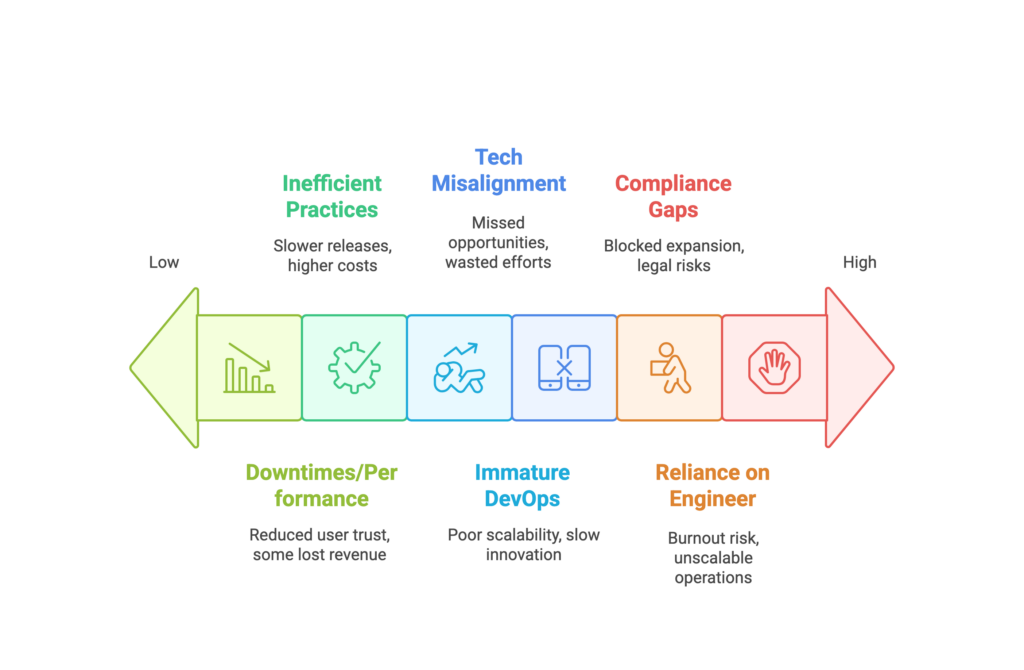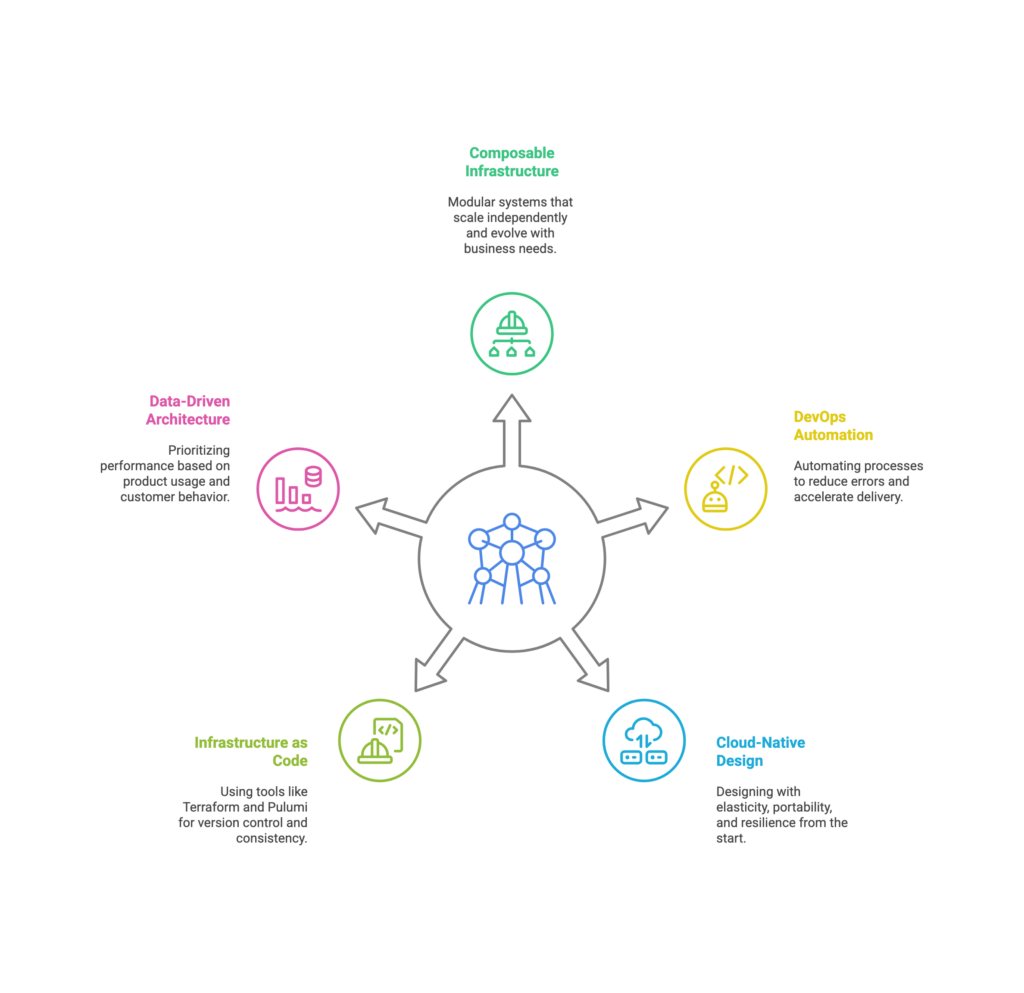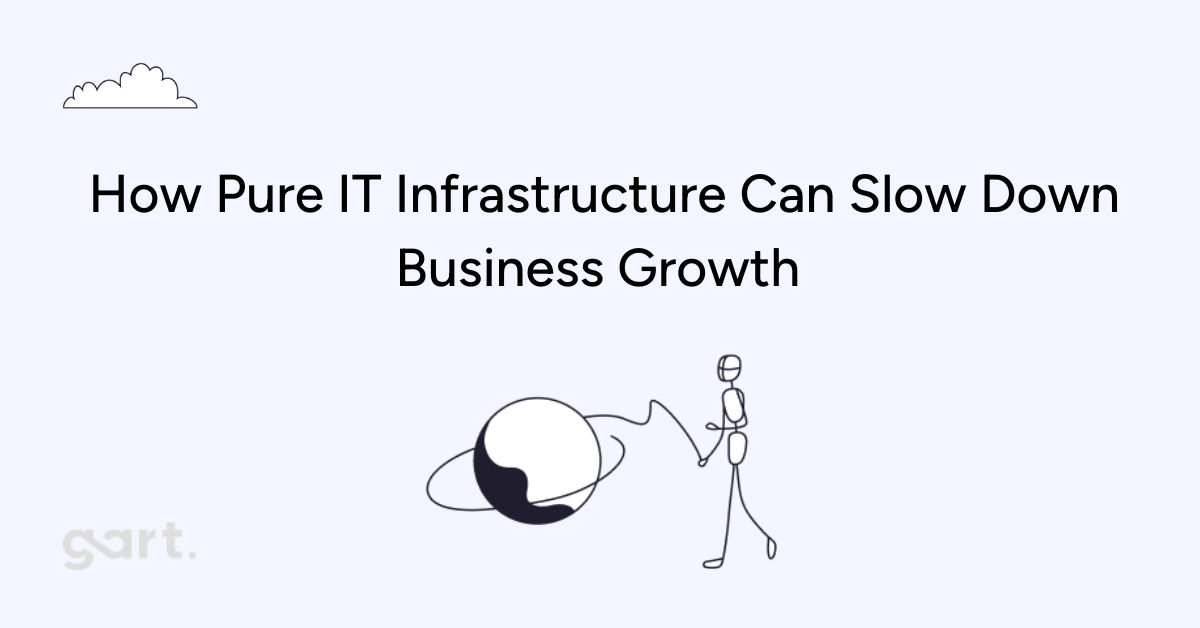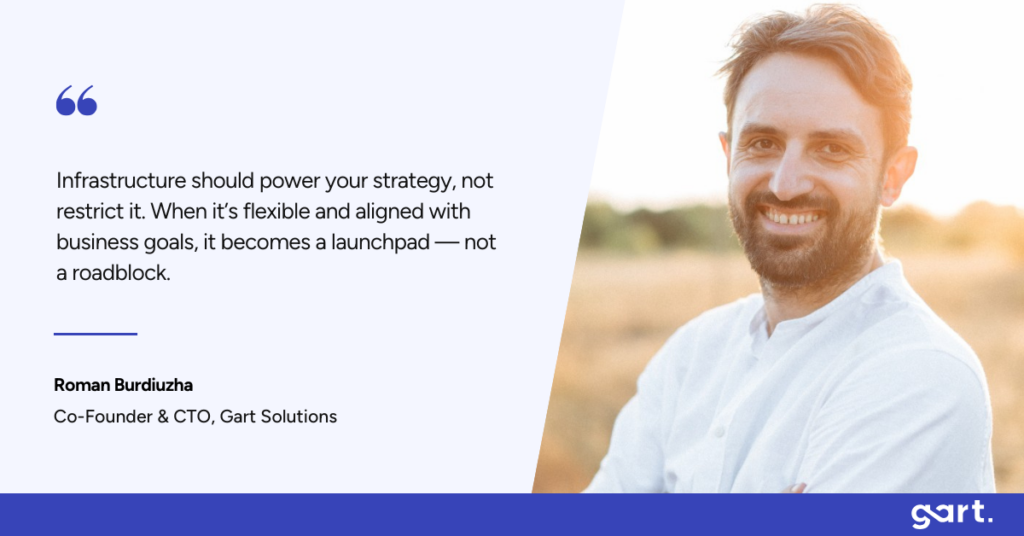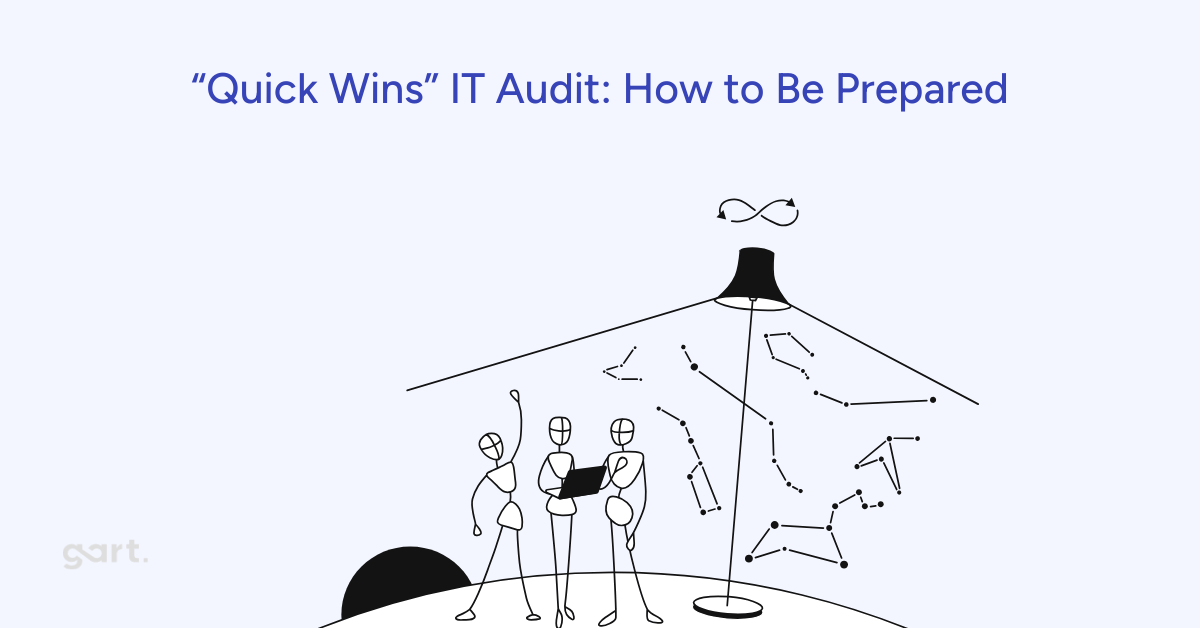
What is a Quick Wins IT Audit?A Quick Wins IT Audit is a fast, focused assessment of your IT infrastructure designed to uncover immediate performance, security, and cost-saving improvements with minimal time and resource investment. It offers rapid insights without the complexity of traditional long-term audits.
Maintaining a robust IT infrastructure is essential for business success. However, traditional IT audits can be complex, time-consuming, and resource-intensive.
For companies seeking immediate insights and tangible improvements, especially within limited time and financial resources, Gart Solutions created a Quick Wins IT Audit that provides a streamlined, efficient alternative. It proposes Infrastructure Audit, Compliance, and Security Audit, all in one.
This assessment focuses on delivering immediate value without the complexity of long-term engagements, making it an ideal solution for businesses looking to optimize their IT infrastructure quickly and effectively.
Below is an example of an IT Audit report reference:
Why Choose a Quick Wins IT Audit?
Maintaining a modern IT infrastructure is essential, but traditional audits can be time-consuming, expensive, and overwhelming.
For businesses seeking rapid impact without long-term contracts, Gart Solutions’ Quick Wins IT Audit provides a streamlined solution. This service combines an infrastructure, compliance, and security audit into one focused assessment, delivering maximum value with minimal friction.
Core Components of a Quick Wins IT Infrastructure Audit
A Quick Wins IT Audit typically includes several key areas of focus, each designed to uncover immediate opportunities for improvement.
1. Review of Existing Infrastructure
Cost Efficiency: analyzing current infrastructure costs to identify potential savings.
Infrastructure Architecture: evaluating the architecture to ensure it meets performance and scalability needs.
Performance Overview: checking the overall performance of the system to detect bottlenecks.
Monitoring: ensuring monitoring tools and practices are in place to track infrastructure health and performance.
2. Initial Security Audit
Cloud Security: Assessing cloud security protocols to protect against data breaches and cyber threats.
Access Management: Reviewing access controls to ensure only authorized personnel have access to critical systems.
Data Privacy: Ensuring data handling complies with privacy regulations and best practices.
3. Review of Delivery Workflow (CI/CD)
A thorough evaluation of Continuous Integration and Continuous Delivery (CI/CD) practices to identify areas for improvement in the development and deployment pipeline.
4. Report and Roadmap Creation
Report: A comprehensive report detailing potential improvements, benefits, and quick wins.
Roadmap: A high-level roadmap with estimated timelines and resource requirements for implementing improvements.
Step-by-Step Process for Quick Wins Audit
To provide maximum efficiency and clarity, the Quick Wins IT Audit follows a streamlined workflow:
1. Free Consultation
A preliminary discussion to define potential growth areas and explore how our solutions can address them.
2. High-Level Quick Wins Audit
A high-level assessment of the current IT infrastructure and architecture, identifying specific areas for improvement.
3. Planning of Next Steps
Based on audit findings, we plan the next steps, including a detailed technical audit, budgeting, and setting expected outcomes.
4. Implementation of Fixes
Actual work on the identified areas of improvement to make quick, impactful changes.
5. Documentation and Reporting
Regular updates, documentation, and knowledge-sharing with your team to keep everyone informed and aligned.
6. Maintenance and Technical Support
Ongoing maintenance and support, including after-hours support, if necessary, to ensure improvements are sustained.
Expected Outcomes and Cost of a Quick-Wins IT Audit
Quick Wins IT Audits are designed to provide transparent, cost-effective engagements. For example, a Quick Wins Audit costs $500, covering approximately 10 hours of IT architect capacity.
This investment includes:
Infrastructure and Code Base Review: reviewing your IT infrastructure and DevOps code base with read-only access to ensure security and compliance.
Team Communication: coordinating with the development team to discuss development and delivery workflows.
Report Preparation and Presentation: after completing the audit, we prepare and present a comprehensive report detailing findings and recommendations.
Benefits of Conducting a Quick Wins IT Audit
Engaging in a Quick Wins IT Audit offers numerous advantages, making it an excellent choice for businesses looking to optimize their IT operations without extensive commitments.
1. Immediate Value with Minimal Commitment
Quick Wins Audits are short-term projects focused on delivering rapid insights and solutions, allowing businesses to address pressing issues immediately.
2. Tailored Solutions Based on Specific Needs
Whether you're focusing on cost reduction, performance enhancement, or security improvements, the audit can be customized to meet specific business goals.
3. Opportunity to Test Ideas Quickly (Fast Prototyping and Validation)
A Quick Wins Audit allows you to experiment with solutions and validate them quickly, which is particularly valuable for businesses exploring new technologies or methodologies.
4. Low-Risk and Cost-Effective Entry Point
For businesses new to IT consulting or auditing, a Quick Wins Audit offers a low-risk way to experience our expertise. By starting small, you gain insights into our capabilities and see the tangible impact of our work, making it easier to decide on further engagements if needed.
What Does a Quick Wins IT Audit Cost?
Starting at $500, our Quick Wins Audit includes:
~10 hours of senior IT architect time
Infrastructure and codebase review (read-only access)
CI/CD and DevOps workflow evaluation
Final audit report with findings and prioritized recommendations
1:1 presentation and planning session
Conclusion
A Quick Wins IT Audit is your shortcut to actionable infrastructure insights without red tape. Whether you need to reduce costs, secure your systems, or streamline workflows, this assessment delivers fast results without long-term contracts.
By focusing on key areas like cost efficiency, security, and workflow optimization, this audit provides a clear roadmap for improvement, ensuring that businesses can enhance their IT operations effectively.
For companies looking to optimize their infrastructure with minimal risk and maximum impact, a Quick Wins IT Audit is an invaluable tool.
Ready to improve your infrastructure quickly?
Book a meeting with Gart Solutions now or get a closer look at Infrastructure Audit Report.
Cloud-IT-Infrastructure-AuditDownload

By treating infrastructure as software code, IaC empowers teams to leverage the benefits of version control, automation, and repeatability in their cloud deployments.
This article explores the key concepts and benefits of IaC, shedding light on popular tools such as Terraform, Ansible, SaltStack, and Google Cloud Deployment Manager. We'll delve into their features, strengths, and use cases, providing insights into how they enable developers and operations teams to streamline their infrastructure management processes.
IaC Tools Comparison Table
IaC ToolDescriptionSupported Cloud ProvidersTerraformOpen-source tool for infrastructure provisioningAWS, Azure, GCP, and moreAnsibleConfiguration management and automation platformAWS, Azure, GCP, and moreSaltStackHigh-speed automation and orchestration frameworkAWS, Azure, GCP, and morePuppetDeclarative language-based configuration managementAWS, Azure, GCP, and moreChefInfrastructure automation frameworkAWS, Azure, GCP, and moreCloudFormationAWS-specific IaC tool for provisioning AWS resourcesAmazon Web Services (AWS)Google Cloud Deployment ManagerInfrastructure management tool for Google Cloud PlatformGoogle Cloud Platform (GCP)Azure Resource ManagerAzure-native tool for deploying and managing resourcesMicrosoft AzureOpenStack HeatOrchestration engine for managing resources in OpenStackOpenStackInfrastructure as a Code Tools Table
Exploring the Landscape of IaC Tools
The IaC paradigm is widely embraced in modern software development, offering a range of tools for deployment, configuration management, virtualization, and orchestration. Prominent containerization and orchestration tools like Docker and Kubernetes employ YAML to express the desired end state. HashiCorp Packer is another tool that leverages JSON templates and variables for creating system snapshots.
The most popular configuration management tools, namely Ansible, Chef, and Puppet, adopt the IaC approach to define the desired state of the servers under their management.
Ansible functions by bootstrapping servers and orchestrating them based on predefined playbooks. These playbooks, written in YAML, outline the operations Ansible will execute and the targeted resources it will operate on. These operations can include starting services, installing packages via the system's package manager, or executing custom bash commands.
Both Chef and Puppet operate through central servers that issue instructions for orchestrating managed servers. Agent software needs to be installed on the managed servers. While Chef employs Ruby to describe resources, Puppet has its own declarative language.
Terraform seamlessly integrates with other IaC tools and DevOps systems, excelling in provisioning infrastructure resources rather than software installation and initial server configuration.
Unlike configuration management tools like Ansible and Chef, Terraform is not designed for installing software on target resources or scheduling tasks. Instead, Terraform utilizes providers to interact with supported resources.
Terraform can operate on a single machine without the need for a master or managed servers, unlike some other tools. It does not actively monitor the actual state of resources and automatically reapply configurations. Its primary focus is on orchestration. Typically, the workflow involves provisioning resources with Terraform and using a configuration management tool for further customization if necessary.
For Chef, Terraform provides a built-in provider that configures the client on the orchestrated remote resources. This allows for automatic addition of all orchestrated servers to the master server and further customization using Chef cookbooks (Chef's infrastructure declarations).
Optimize your infrastructure management with our DevOps expertise. Harness the power of IaC tools for streamlined provisioning, configuration, and orchestration. Scale efficiently and achieve seamless deployments. Contact us now.
Popular Infrastructure as Code Tools
Terraform
Terraform, introduced by HashiCorp in 2014, is an open-source Infrastructure as Code (IaC) solution. It operates based on a declarative approach to managing infrastructure, allowing you to define the desired end state of your infrastructure in a configuration file. Terraform then works to bring the infrastructure to that desired state. This configuration is applied using the PUSH method. Written in the Go programming language, Terraform incorporates its own language known as HashiCorp Configuration Language (HCL), which is used for writing configuration files that automate infrastructure management tasks.
Download: https://github.com/hashicorp/terraform
Terraform operates by analyzing the infrastructure code provided and constructing a graph that represents the resources and their relationships. This graph is then compared with the cached state of resources in the cloud. Based on this comparison, Terraform generates an execution plan that outlines the necessary changes to be applied to the cloud in order to achieve the desired state, including the order in which these changes should be made.
Within Terraform, there are two primary components: providers and provisioners. Providers are responsible for interacting with cloud service providers, handling the creation, management, and deletion of resources. On the other hand, provisioners are used to execute specific actions on the remote resources created or on the local machine where the code is being processed.
Terraform offers support for managing fundamental components of various cloud providers, such as compute instances, load balancers, storage, and DNS records. Additionally, Terraform's extensibility allows for the incorporation of new providers and provisioners.
In the realm of Infrastructure as Code (IaC), Terraform's primary role is to ensure that the state of resources in the cloud aligns with the state expressed in the provided code. However, it's important to note that Terraform does not actively track deployed resources or monitor the ongoing bootstrapping of prepared compute instances. The subsequent section will delve into the distinctions between Terraform and other tools, as well as how they complement each other within the workflow.
Real-World Examples of Terraform Usage
Terraform has gained immense popularity across various industries due to its versatility and user-friendly nature. Here are a few real-world examples showcasing how Terraform is being utilized:
CI/CD Pipelines and Infrastructure for E-Health Platform
For our client, a development company specializing in Electronic Medical Records Software (EMRS) for government-based E-Health platforms and CRM systems in medical facilities, we leveraged Terraform to create the infrastructure using VMWare ESXi. This allowed us to harness the full capabilities of the local cloud provider, ensuring efficient and scalable deployments.
Implementation of Nomad Cluster for Massively Parallel Computing
Our client, S-Cube, is a software development company specializing in creating a product based on a waveform inversion algorithm for building Earth models. They sought to enhance their infrastructure by separating the software from the underlying infrastructure, allowing them to focus solely on application development without the burden of infrastructure management.
To assist S-Cube in achieving their goals, Gart Solutions stepped in and leveraged the latest cloud development techniques and technologies, including Terraform. By utilizing Terraform, Gart Solutions helped restructure the architecture of S-Cube's SaaS platform, making it more economically efficient and scalable.
The Gart Solutions team worked closely with S-Cube to develop a new approach that takes infrastructure management to the next level. By adopting Terraform, they were able to define their infrastructure as code, enabling easy provisioning and management of resources across cloud and on-premises environments. This approach offered S-Cube the flexibility to run their workloads in both containerized and non-containerized environments, adapting to their specific requirements.
Streamlining Presale Processes with ChatOps Automation
Our client, Beyond Risk, is a dynamic technology company specializing in enterprise risk management solutions. They faced several challenges related to environmental management, particularly in managing the existing environment architecture and infrastructure code conditions, which required significant effort.
To address these challenges, Gart implemented ChatOps Automation to streamline the presale processes. The implementation involved utilizing the Slack API to create an interactive flow, AWS Lambda for implementing the business logic, and GitHub Action + Terraform Cloud for infrastructure automation.
One significant improvement was the addition of a Notification step, which helped us track the success or failure of Terraform operations. This allowed us to stay informed about the status of infrastructure changes and take appropriate actions accordingly.
Unlock the full potential of your infrastructure with our DevOps expertise. Maximize scalability and achieve flawless deployments. Drop us a line right now!
AWS CloudFormation
AWS CloudFormation is a powerful Infrastructure as Code (IaC) tool provided by Amazon Web Services (AWS). It simplifies the provisioning and management of AWS resources through the use of declarative CloudFormation templates. Here are the key features and benefits of AWS CloudFormation, its declarative infrastructure management approach, its integration with other AWS services, and some real-world case studies showcasing its adoption.
Key Features and Advantages:
Infrastructure as Code: CloudFormation enables you to define and manage your infrastructure resources using templates written in JSON or YAML. This approach ensures consistent, repeatable, and version-controlled deployments of your infrastructure.
Automation and Orchestration: CloudFormation automates the provisioning and configuration of resources, ensuring that they are created, updated, or deleted in a controlled and predictable manner. It handles resource dependencies, allowing for the orchestration of complex infrastructure setups.
Infrastructure Consistency: With CloudFormation, you can define the desired state of your infrastructure and deploy it consistently across different environments. This reduces configuration drift and ensures uniformity in your infrastructure deployments.
Change Management: CloudFormation utilizes stacks to manage infrastructure changes. Stacks enable you to track and control updates to your infrastructure, ensuring that changes are applied consistently and minimizing the risk of errors.
Scalability and Flexibility: CloudFormation supports a wide range of AWS resource types and features. This allows you to provision and manage compute instances, databases, storage volumes, networking components, and more. It also offers flexibility through custom resources and supports parameterization for dynamic configurations.
Case studies showcasing CloudFormation adoption
Netflix leverages CloudFormation for managing their infrastructure deployments at scale. They use CloudFormation templates to provision resources, define configurations, and enable repeatable deployments across different regions and accounts.
Yelp utilizes CloudFormation to manage their AWS infrastructure. They use CloudFormation templates to provision and configure resources, enabling them to automate and simplify their infrastructure deployments.
Dow Jones, a global news and business information provider, utilizes CloudFormation for managing their AWS resources. They leverage CloudFormation to define and provision their infrastructure, enabling faster and more consistent deployments.
Ansible
Perhaps Ansible is the most well-known configuration management system used by DevOps engineers. This system is written in the Python programming language and uses a declarative markup language to describe configurations. It utilizes the PUSH method for automating software configuration and deployment.
What are the main differences between Ansible and Terraform? Ansible is a versatile automation tool that can be used to solve various tasks, while Terraform is a tool specifically designed for "infrastructure as code" tasks, which means transforming configuration files into functioning infrastructure.
Use cases highlighting Ansible's versatility
Configuration Management: Ansible is commonly used for configuration management, allowing you to define and enforce the desired configurations across multiple servers or network devices. It ensures consistency and simplifies the management of configuration drift.
Application Deployment: Ansible can automate the deployment of applications by orchestrating the installation, configuration, and updates of application components and their dependencies. This enables faster and more reliable application deployments.
Cloud Provisioning: Ansible integrates seamlessly with various cloud providers, enabling the provisioning and management of cloud resources. It allows you to define infrastructure in a cloud-agnostic way, making it easy to deploy and manage infrastructure across different cloud platforms.
Continuous Delivery: Ansible can be integrated into a continuous delivery pipeline to automate the deployment and testing of applications. It allows for efficient and repeatable deployments, reducing manual errors and accelerating the delivery of software updates.
Google Cloud Deployment Manager
Google Cloud Deployment Manager is a robust Infrastructure as Code (IaC) solution offered by Google Cloud Platform (GCP). It empowers users to define and manage their infrastructure resources using Deployment Manager templates, which facilitate automated and consistent provisioning and configuration.
By utilizing YAML or Jinja2-based templates, Deployment Manager enables the definition and configuration of infrastructure resources. These templates specify the desired state of resources, encompassing various GCP services, networks, virtual machines, storage, and more. Users can leverage templates to define properties, establish dependencies, and establish relationships between resources, facilitating the creation of intricate infrastructures.
Deployment Manager seamlessly integrates with a diverse range of GCP services and ecosystems, providing comprehensive resource management capabilities. It supports GCP's native services, including Compute Engine, Cloud Storage, Cloud SQL, Cloud Pub/Sub, among others, enabling users to effectively manage their entire infrastructure.
Puppet
Puppet is a widely adopted configuration management tool that helps automate the management and deployment of infrastructure resources. It provides a declarative language and a flexible framework for defining and enforcing desired system configurations across multiple servers and environments.
Puppet enables efficient and centralized management of infrastructure configurations, making it easier to maintain consistency and enforce desired states across a large number of servers. It automates repetitive tasks, such as software installations, package updates, file management, and service configurations, saving time and reducing manual errors.
Puppet operates using a client-server model, where Puppet agents (client nodes) communicate with a central Puppet server to retrieve configurations and apply them locally. The Puppet server acts as a repository for configurations and distributes them to the agents based on predefined rules.
Pulumi
Pulumi is a modern Infrastructure as Code (IaC) tool that enables users to define, deploy, and manage infrastructure resources using familiar programming languages. It combines the concepts of IaC with the power and flexibility of general-purpose programming languages to provide a seamless and intuitive infrastructure management experience.
Pulumi has a growing ecosystem of libraries and plugins, offering additional functionality and integrations with external tools and services. Users can leverage existing libraries and modules from their programming language ecosystems, enhancing the capabilities of their infrastructure code.
There are often situations where it is necessary to deploy an application simultaneously across multiple clouds, combine cloud infrastructure with a managed Kubernetes cluster, or anticipate future service migration. One possible solution for creating a universal configuration is to use the Pulumi project, which allows for deploying applications to various clouds (GCP, Amazon, Azure, AliCloud), Kubernetes, providers (such as Linode, Digital Ocean), virtual infrastructure management systems (OpenStack), and local Docker environments.
Pulumi integrates with popular CI/CD systems and Git repositories, allowing for the creation of infrastructure as code pipelines.
Users can automate the deployment and management of infrastructure resources as part of their overall software delivery process.
SaltStack
SaltStack is a powerful Infrastructure as Code (IaC) tool that automates the management and configuration of infrastructure resources at scale. It provides a comprehensive solution for orchestrating and managing infrastructure through a combination of remote execution, configuration management, and event-driven automation.
SaltStack enables remote execution across a large number of servers, allowing administrators to execute commands, run scripts, and perform tasks on multiple machines simultaneously. It provides a robust configuration management framework, allowing users to define desired states for infrastructure resources and ensure their continuous enforcement.
SaltStack is designed to handle massive infrastructures efficiently, making it suitable for organizations with complex and distributed environments.
The SaltStack solution stands out compared to others mentioned in this article. When creating SaltStack, the primary goal was to achieve high speed. To ensure high performance, the architecture of the solution is based on the interaction between the Salt-master server components and Salt-minion clients, which operate in push mode using Salt-SSH.
The project is developed in Python and is hosted in the repository at https://github.com/saltstack/salt.
The high speed is achieved through asynchronous task execution. The idea is that the Salt Master communicates with Salt Minions using a publish/subscribe model, where the master publishes a task and the minions receive and asynchronously execute it. They interact through a shared bus, where the master sends a single message specifying the criteria that minions must meet, and they start executing the task. The master simply waits for information from all sources, knowing how many minions to expect a response from. To some extent, this operates on a "fire and forget" principle.
In the event of the master going offline, the minion will still complete the assigned work, and upon the master's return, it will receive the results.
The interaction architecture can be quite complex, as illustrated in the vRealize Automation SaltStack Config diagram below.
When comparing SaltStack and Ansible, due to architectural differences, Ansible spends more time processing messages. However, unlike SaltStack's minions, which essentially act as agents, Ansible does not require agents to function. SaltStack is significantly easier to deploy compared to Ansible, which requires a series of configurations to be performed. SaltStack does not require extensive script writing for its operation, whereas Ansible is quite reliant on scripting for interacting with infrastructure.
Additionally, SaltStack can have multiple masters, so if one fails, control is not lost. Ansible, on the other hand, can have a secondary node in case of failure. Finally, SaltStack is supported by GitHub, while Ansible is supported by Red Hat.
SaltStack integrates seamlessly with cloud platforms, virtualization technologies, and infrastructure services.
It provides built-in modules and functions for interacting with popular cloud providers, making it easier to manage and provision resources in cloud environments.
SaltStack offers a highly extensible framework that allows users to create custom modules, states, and plugins to extend its functionality.
It has a vibrant community contributing to a rich ecosystem of Salt modules and extensions.
Chef
Chef is a widely recognized and powerful Infrastructure as Code (IaC) tool that automates the management and configuration of infrastructure resources. It provides a comprehensive framework for defining, deploying, and managing infrastructure across various platforms and environments.
Chef allows users to define infrastructure configurations as code, making it easier to manage and maintain consistent configurations across multiple servers and environments.
It uses a declarative language called Chef DSL (Domain-Specific Language) to define the desired state of resources and systems.
Chef Solo
Chef also offers a standalone mode called Chef Solo, which does not require a central Chef server.
Chef Solo allows for the local execution of cookbooks and recipes on individual systems without the need for a server-client setup.
Benefits of Infrastructure as Code Tools
Infrastructure as Code (IaC) tools offer numerous benefits that contribute to efficient, scalable, and reliable infrastructure management.
IaC tools automate the provisioning, configuration, and management of infrastructure resources. This automation eliminates manual processes, reducing the potential for human error and increasing efficiency.
With IaC, infrastructure configurations are defined and deployed consistently across all environments. This ensures that infrastructure resources adhere to desired states and defined standards, leading to more reliable and predictable deployments.
IaC tools enable easy scalability by providing the ability to define infrastructure resources as code. Scaling up or down becomes a matter of modifying the code or configuration, allowing for rapid and flexible infrastructure adjustments to meet changing demands.
Infrastructure code can be stored and version-controlled using tools like Git. This enables collaboration among team members, tracking of changes, and easy rollbacks to previous configurations if needed.
Infrastructure code can be structured into reusable components, modules, or templates. These components can be shared across projects and environments, promoting code reusability, reducing duplication, and speeding up infrastructure deployment.
Infrastructure as Code tools automate the provisioning and deployment processes, significantly reducing the time required to set up and configure infrastructure resources. This leads to faster application deployment and delivery cycles.
Infrastructure as Code tools provide an audit trail of infrastructure changes, making it easier to track and document modifications. They also assist in achieving compliance by enforcing predefined policies and standards in infrastructure configurations.
Infrastructure code can be used to recreate and recover infrastructure quickly in the event of a disaster. By treating infrastructure as code, organizations can easily reproduce entire environments, reducing downtime and improving disaster recovery capabilities.
IaC tools abstract infrastructure configurations from specific cloud providers, allowing for portability across multiple cloud platforms. This flexibility enables organizations to leverage different cloud services based on specific requirements or to migrate between cloud providers easily.
Infrastructure as Code tools provide visibility into infrastructure resources and their associated costs. This visibility enables organizations to optimize resource allocation, identify unused or underutilized resources, and make informed decisions for cost optimization.
Considerations for Choosing an IaC Tool
When selecting an Infrastructure as Code (IaC) tool, it's essential to consider various factors to ensure it aligns with your specific requirements and goals.
Compatibility with Infrastructure and Environments
Determine if the IaC tool supports the infrastructure platforms and technologies you use, such as public clouds (AWS, Azure, GCP), private clouds, containers, or on-premises environments.
Check if the tool integrates well with existing infrastructure components and services you rely on, such as databases, load balancers, or networking configurations.
Supported Programming Languages
Consider the programming languages supported by the IaC tool. Choose a tool that offers support for languages that your team is familiar with and comfortable using.
Ensure that the tool's supported languages align with your organization's coding standards and preferences.
Learning Curve and Ease of Use
Evaluate the learning curve associated with the IaC tool. Consider the complexity of its syntax, the availability of documentation, tutorials, and community support.
Determine if the tool provides an intuitive and user-friendly interface or a command-line interface (CLI) that suits your team's preferences and skill sets.
Declarative or Imperative Approach
Decide whether you prefer a declarative or imperative approach to infrastructure management.
Declarative tools focus on defining the desired state of infrastructure resources, while imperative Infrastructure as Code tools allow more procedural control over infrastructure changes.
Consider which approach aligns better with your team's mindset and infrastructure management style.
Extensibility and Customization
Evaluate the extensibility and customization options provided by the IaC tool. Check if it allows the creation of custom modules, plugins, or extensions to meet specific requirements.
Consider the availability of a vibrant community and ecosystem around the tool, providing additional resources, libraries, and community-contributed content.
Collaboration and Version Control
Assess the tool's collaboration features and support for version control systems like Git.
Determine if it allows multiple team members to work simultaneously on infrastructure code, provides conflict resolution mechanisms, and supports code review processes.
Security and Compliance
Examine the tool's security features and its ability to meet security and compliance requirements.
Consider features like access controls, encryption, secrets management, and compliance auditing capabilities to ensure the tool aligns with your organization's security standards.
Community and Support
Evaluate the size and activity of the tool's community, as it can greatly impact the availability of resources, forums, and support.
Consider factors like the frequency of updates, bug fixes, and the responsiveness of the tool's maintainers to address issues or feature requests.
Cost and Licensing
Assess the licensing model of the IaC tool. Some Infrastructure as Code Tools may have open-source versions with community support, while others offer enterprise editions with additional features and support.
Consider the total cost of ownership, including licensing fees, training costs, infrastructure requirements, and ongoing maintenance.
Roadmap and Future Development
Research the tool's roadmap and future development plans to ensure its continued relevance and compatibility with evolving technologies and industry trends.
By considering these factors, you can select Infrastructure as Code Tools that best fits your organization's needs, infrastructure requirements, team capabilities, and long-term goals.
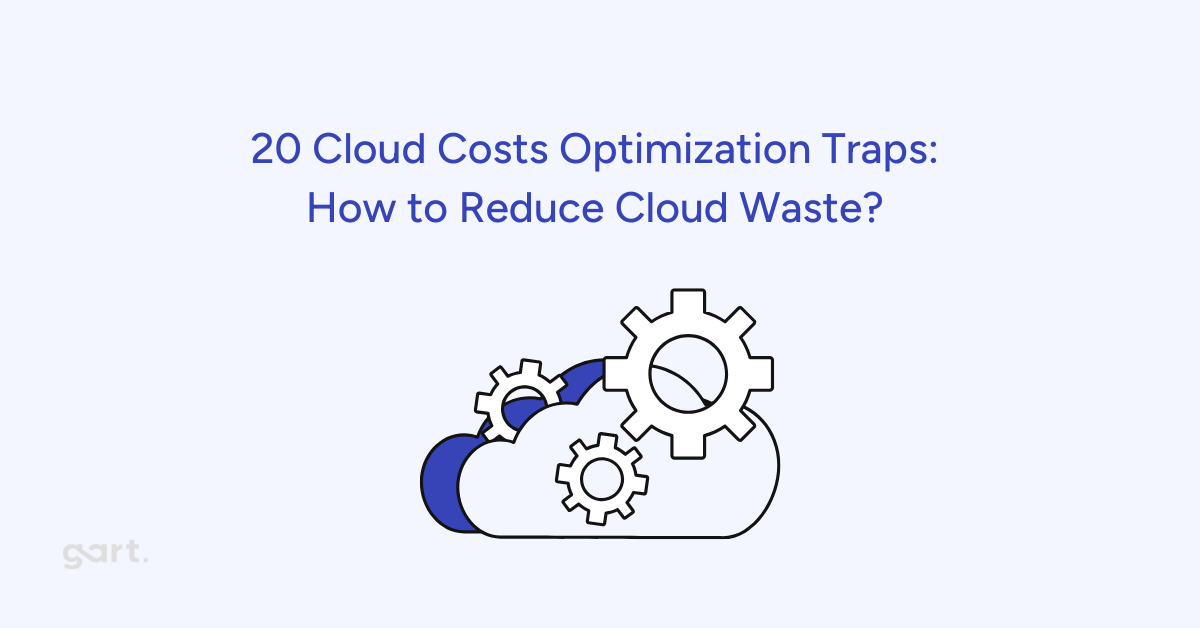
Organizations often expect to cut costs when migrating IT infrastructure from on-premises setups to the cloud. However, the reality can be starkly different. Various cost traps can emerge during cloud transformation, leading to unexpectedly high expenses if not carefully managed.
In this article, we will explore the most common cloud cost traps and provide strategies to avoid cloud expenditures during cloud transformation.
Estimating Cloud Transformation Expenses
Forecasting expenses during a cloud transformation can be challenging. In traditional IT setups, cost estimation is relatively straightforward, encompassing fixed costs such as data center rent, hardware, and licenses. Conversely, in a cloud environment, you pay based on usage, which can fluctuate greatly, complicating cost predictions.
This variability often leads to unforeseen cost spikes during cloud transformation.
At Gart Solutions, we help numerous organizations navigate their cloud transformation journeys and frequently encounter five key mistakes that can drive up costs.
Common Cloud Costs Optimization Traps Happening There:
1. The "Lift and Shift" Approach
A common mistake is migrating existing setups to the cloud without modifications, known as a "lift and shift." This method usually leads to high costs because it fails to leverage the cloud's unique advantages.
Instead, organizations should modernize their solutions through "refactoring." Refactoring involves changing or completely replacing applications or systems to exploit the cloud's benefits such as scalability, elasticity, self-service, and measurability. By optimizing resources for the cloud, organizations can achieve greater flexibility, efficiency, and cost savings.
2. Choosing the Wrong IT Architecture Setup
Selecting the right architecture for a cloud environment is critical. IT architecture must be carefully planned to maximize cloud benefits. Determining how services interact and which ones to use requires an architecture tailored to the organization’s needs. Poor architectural choices can result in an environment that does not meet security and scalability requirements, leading to costly adjustments. Hence, it's vital to seek expert advice, critically review recommendations, and explore alternatives that do not compromise functionality or performance.
Contact Gart & get the IT Infrastructure Consulting. Quick and long-term wins are guaranteed.
3. Overreliance on Enterprise Versions
Organizations often default to enterprise versions of cloud services without assessing their actual needs. This can result in unnecessarily high costs. Before opting for enterprise versions, it's crucial to evaluate if standard versions can meet the requirements.
Contact Gart & assess cloud services carefully.
4. Uncontrolled Capacity Planning
Accurately predicting capacity needs is a common challenge, where previous expertise is needed. Capacity requirements can vary — constant for some, linear for others, exponential for a third, and seasonal for a fourth. These variations can lead to over- or under-provisioning of resources, resulting in additional costs. Effective capacity planning involves basic estimates and continuous monitoring to detect changes in needs and adjust resources accordingly. Utilizing the built-in capabilities of cloud services for business alignment requires the right expertise.
Contact Gart to assess your resources and requirements and make optimal capacity planning.
5. Lack of Appropriate Skills
Cloud transformation increases IT delivery complexity and requires new skills. Without the right expertise, projects can become inefficient, leading to wrong decisions and increased costs.
Contact Gart - we are the trusted partner in cloud consulting, migration, and cost optimization.
6. Underestimating Data Transfer Costs
One often overlooked cost trap is data transfer. While moving data to the cloud might seem straightforward, the costs associated with data egress (data leaving the cloud) can be substantial. Organizations should be aware of these charges and plan data transfer strategies accordingly, such as optimizing data placement and minimizing data transfer needs.
7. Neglecting Long-term Cost Implications
Focusing solely on immediate cost savings can lead to higher long-term expenses. Organizations should consider the long-term implications of their cloud choices, including potential costs associated with scaling, maintenance, and upgrades. A comprehensive cost-benefit analysis that includes future scenarios can help in making more informed decisions.
8. Ignoring Security and Compliance Costs
Security and compliance are critical in cloud environments, and neglecting these aspects can lead to significant expenses. Ensuring that cloud deployments comply with regulatory standards and implementing robust security measures can prevent costly breaches and fines. Investing in security tools and expertise upfront is crucial for avoiding unexpected costs later.
Contact for consulting in security, architecture, and cloud technologies. Prevent unnecessary expenses and ensure a smooth transition.
9. Failing to Monitor and Optimize Usage
Continuous monitoring and optimization of cloud usage are essential for controlling costs. Without proper monitoring, organizations can easily overspend on unnecessary resources. Utilizing cloud management tools and implementing policies for regular audits and optimizations can help keep costs in check.
10. Overlooking Vendor Lock-in Risks
Vendor lock-in occurs when an organization becomes overly dependent on a single cloud provider, making it difficult and costly to switch providers. To mitigate this risk, organizations should adopt a multi-cloud strategy or ensure that their architecture allows for flexibility and portability across different cloud platforms.
11. Underutilizing Reserved Instances and Savings Plans
Cloud providers offer reserved instances and savings plans that can significantly reduce costs for predictable workloads. However, many organizations fail to take advantage of these options. By analyzing usage patterns and committing to long-term plans, organizations can achieve substantial savings compared to on-demand pricing.
12. Over-Provisioning Resources
Over-provisioning, or allocating more resources than needed, is a common cost trap. This often results from a lack of understanding of actual usage requirements. Implementing auto-scaling and right-sizing strategies can help in dynamically adjusting resources based on real-time demand, thus avoiding unnecessary expenses.
13. Lack of Governance and Policies
Effective governance and policies are crucial for managing cloud costs. Without proper governance, organizations can face uncontrolled spending and resource mismanagement. Establishing clear policies for resource usage, cost allocation, and accountability ensures that cloud resources are used efficiently, and costs are kept under control.
14. Neglecting to Decommission Unused Resources
Failing to decommission unused or idle resources can lead to wasted spending. Regularly reviewing and cleaning up unused instances, storage, and other resources can help in reducing unnecessary costs. Automation tools can assist in identifying and decommissioning these resources.
15. Ignoring Cloud Cost Management Tools
Most cloud providers offer cost management and optimization tools, but organizations often overlook these valuable resources. Utilizing these tools can provide insights into spending patterns, help identify cost-saving opportunities, and enable more effective budgeting and forecasting.
16. Misjudging Data Storage Costs
Data storage costs can add up quickly, especially if organizations do not manage their data efficiently. Implementing data lifecycle policies, such as archiving old data and deleting redundant data, can help control storage costs. Additionally, selecting the appropriate storage class based on access frequency and performance needs is essential.
17. Overlooking Software Licensing Costs
Cloud transformation can sometimes lead to increased software licensing costs, particularly if organizations do not review their licensing agreements carefully. It's important to understand the licensing implications of moving to the cloud and to negotiate contracts that align with cloud usage patterns.
18. Inadequate Backup and Disaster Recovery Planning
Backup and disaster recovery are critical components of cloud strategy, but inadequate planning in these areas can lead to unexpected costs. Organizations should ensure that their backup and recovery plans are cost-effective and align with their overall cloud strategy. This includes selecting the right tools and services for efficient data protection and recovery.
19. Failing to Leverage Cloud Provider Discounts
Cloud providers often offer discounts for committed usage, volume purchases, and other incentives. Failing to leverage these discounts can result in higher costs. Organizations should actively seek out and take advantage of available discounts to optimize their cloud spending.
Contact Gart and calculate cloud discounts for your case.
20. Not Considering Hidden Costs
Hidden costs, such as those related to network latency, data retrieval, and specialized support, can significantly impact the overall cloud budget. Organizations should thoroughly assess all potential costs, including those that may not be immediately apparent, to avoid budget surprises.
Final words
Cloud transformation requires specialized expertise & careful planning.
Contact us to address all organizational needs for a successful cloud transformation.
Gart Solutions can help your organization avoid common cost traps and achieve business objectives efficiently.
Review our latest Case Studies of our cloud migration & cost optimization projects.
